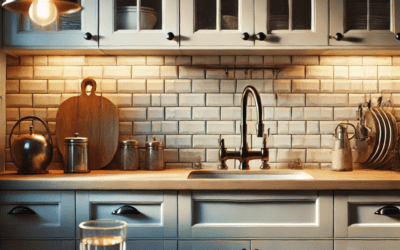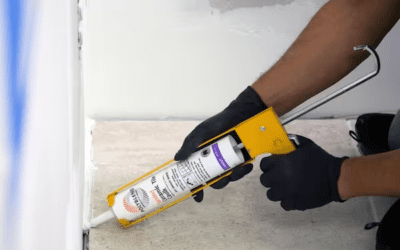A well-maintained deck is the highlight of any outdoor space. Still, nothing diminishes its beauty faster than peeling and fading. Like many others, Philadelphia homeowners know that decks endure extreme weather conditions that can lead to these issues. From harsh winters to scorching summers, your deck faces a constant barrage of elements. These elements can cause the wood to deteriorate over time. Fortunately, with proper care and preventative measures, you can extend the life of your deck and keep it looking new.
In this guide, we’ll cover the best practices for preventing deck peeling and fading while ensuring your deck remains a stunning part of your home for years to come. Let’s get started!
Deck Peeling
What is Deck Peeling?
Deck peeling is one of the most common issues that deck owners face. It happens when a deck’s top layer of paint or stain starts to lift, crack, or come off in flakes. Deck peeling typically occurs due to inadequate preparation before painting, staining or prolonged exposure to harsh weather conditions. Moisture can seep into the wood, causing the finish to peel. It’s a common problem, especially with decks that don’t get regular maintenance, like resealing or restaining. This can make the deck look old and worn out.
Figure 1: Deck Peeling
Understanding the Causes of Deck Peeling
Here are some common causes of deck peeling:
- Poor Surface Preparation: If the deck wasn’t properly cleaned, sanded, or prepped before applying paint or stain, the finish can’t stick well, leading to peeling.
- Moisture: Water can get into the wood, especially if it isn’t sealed correctly. Over time, this moisture causes the paint or stain to lift and peel off.
- Sun Exposure: UV rays can break down the protective finish, causing it to weaken and peel, especially if the deck is exposed to a lot of direct sunlight.
- Using the Wrong Product: If the stain or paint isn’t meant for outdoor use or isn’t compatible with the deck material, it won’t last long and will start peeling.
- Over-application: Applying too thick of a coat of paint or stain can prevent it from fully bonding to the wood, leading to peeling as the top layer dries unevenly.
- Old Finish: If the deck isn’t maintained or refinished regularly, the old finish can break down and peel off over time.
- Temperature Changes: Constant changes in temperature can cause the wood to expand and contract, weakening the paint or stain and making it peel.
The reasons behind deck peeling can differ based on the material, and so can the solutions. Wooden decks tend to peel when moisture gets into the wood. This causes it to swell and shrink, which cracks the paint or stain. Composite decks can peel if the surface wears down or the material is not manufactured correctly, leading to delamination. Peeling on painted or stained concrete decks often occurs when the surface is improperly prepared. It also happens when coatings are applied in unsuitable weather conditions. Vinyl or PVC decks can peel if the surface isn’t properly cleaned before applying a sealant or if they are exposed to UV rays for prolonged periods. In every case, poor maintenance can speed up the peeling process.
Table 1: Deck Peeling Causes by Material
|
Deck Type |
Fading Cause |
|
Wooden Decks |
Moisture |
|
Composite Decks |
Surface wear or improper manufacturing |
|
Concrete Decks |
Peeling occurs when the surface isn’t properly prepared or coatings are applied in unsuitable weather. |
|
Vinyl/PVC Decks |
Peeling can happen if the surface isn’t cleaned before applying a sealant or from prolonged UV exposure. |
How to Prevent Deck Peeling?
Here’s how to prevent deck peeling:
- Clean the Surface Properly: Before you apply any stain or paint, make sure the deck is completely clean and free of dirt, debris, and old peeling layers. A clean surface helps the new finish stick better. A power washer is an effective tool, but be careful not to use too much pressure, which can damage the wood. After cleaning, allow the deck to dry completely, which may take a few days, depending on the weather.
- Sand the Deck: Lightly sanding the deck can smooth out the surface and help the paint or stain bond properly with the wood, reducing the chances of peeling.
- Use the Right Products: Choose high-quality outdoor paints or stains made for deck use. These are designed to handle the weather and won’t peel as easily. A penetrating stain is a better option than a film-forming paint to prevent deck peeling. Penetrating stains soak into the wood rather than sitting on top. This makes them less likely to peel as the wood expands and contracts with changing weather conditions.
- Apply Primer: It is crucial to use a primer before painting painted decks. Primer helps the paint adhere to the wood and creates a more durable finish, reducing the risk of deck peeling.
- Apply Thin Coats: Use thin, even coats when staining or painting. Applying too much at once can cause the top layer to dry unevenly, which leads to peeling.
- Install a Proper Drainage System: Excess moisture is one of the primary causes of deck peeling, so it’s essential to keep your deck as dry as possible. A proper drainage system can help by preventing water from pooling on the deck’s surface or seeping into the wood. Ensure that your deck has a slight slope to allow rainwater to run off, and regularly inspect the deck for standing water.
- Seal the Deck: After staining or painting, apply a good sealant to protect the deck from moisture. This helps keep water out of the wood and prevents peeling.
- Maintain Regularly: Perform regular maintenance, like cleaning the deck and resealing it every few years. This keeps the finish in good condition and prevents peeling before it starts.
- Avoid Extreme Weather During Application: Don’t stain or paint the deck when it’s too hot, cold, or humid, as extreme conditions can affect how the finish bonds to the wood.
How to Fix a Deck that is Peeled?
To fix a peeled deck, start by scraping off as much of the old finish as possible and resetting any nails or screws sticking out. Next, apply a deck stain remover to small sections at a time, covering nearby plants and siding to protect them. Let the remover sit for 15-30 minutes, then scrub the old stain off with a stiff brush and rinse thoroughly. If there are tough spots, sand them with a coarse pad or disc to smooth the surface.
After sanding, apply a wood brightener or conditioner to restore the wood’s natural color, then rinse it off and let the deck dry. Once dry, apply a quality oil-based deck stain specifically designed for outdoor use. Avoid using siding paint or stains not made for decks, as they tend to peel. Following these steps will give your deck a fresh, long-lasting finish.
Deck Fading
What is Deck Fading?
Deck fading is when the color of your deck starts to lose its brightness and looks dull or washed out over time. Deck fading typically occurs due to exposure to sunlight, rain, and other weather elements. UV rays from the sun are the leading cause, as they break down the color pigments in the wood or stain. It’s a natural process that affects both wood and composite decks. The good news is that you can refresh the color by cleaning the deck and applying a new coat of stain or paint to bring it back to life.
Figure 2: Deck Fading
Understanding the Causes of Deck Fading
Here are some common causes of deck fading:
- Sun Exposure: The most significant cause of fading is the sun’s UV rays, which break down the pigments in paint or stain, making the color look dull and washed out over time.
- Rain and Moisture: Constant exposure to rain or humidity can cause the color to fade, especially if the deck isn’t properly sealed to protect it from moisture.
- Improper Stain or Paint: Using a low-quality or the wrong stain or paint can lead to faster fading. Outdoor decks need specific products that can withstand the elements.
- Wear and Tear: Regular foot traffic, dragging furniture, or placing heavy objects can gradually wear down the surface, leading to faded areas over time.
- Lack of Maintenance: If the deck isn’t cleaned and restained regularly, dirt, grime, and natural elements can break down the color, causing it to fade quickly.
Again, the factors mentioned above can affect different deck materials in various ways. While UV exposure is the leading cause of deck fading, the rate and severity can differ depending on the material and climate. Wooden decks, especially softwoods like cedar or pine, fade as the sun breaks down their natural oils and pigments. Composite decks lose color as their UV protection weakens over time. Concrete decks can fade if the pigments in the finish are not properly sealed. Even though vinyl or PVC decks are generally more resistant to fading, prolonged exposure to intense sunlight and harsh weather can still cause some color loss.
Table 2: Deck Fading Causes by Material
|
Deck Type |
Fading Cause |
|
Wooden Decks |
UV exposure breaks down natural oils and pigments, especially in softwoods like cedar or pine. |
|
Composite Decks |
UV inhibitors wear off over time, leading to color loss. |
|
Concrete Decks |
Sunlight impacts pigments in the finish if not properly sealed. |
|
Vinyl/PVC Decks |
Constant exposure to harsh sunlight and bad weather. |
How to Prevent Deck Fading?
Here’s how to prevent deck fading:
- Use UV-Resistant Stain or Paint: Choose a stain or paint that specifically protects against UV rays. This helps keep the color from fading due to sun exposure.
- Apply a Sealant: After staining or painting, use a clear sealant to protect against the sun, rain, and other weather elements. This helps lock in the color and keep it looking fresh longer.
- Clean the Deck Regularly: Dirt, grime, and mildew can speed up fading. Regularly cleaning the deck removes these elements and helps preserve the color.
- Reapply Stain or Paint as Needed: Reapply a fresh coat of stain or paint every few years. This keeps the color vibrant and protects the wood from fading over time.
- Add Shade: If possible, add shade to your deck with umbrellas, pergolas, or awnings. This reduces the amount of direct sun exposure and helps slow down the fading process.
- Avoid Harsh Cleaners: Use gentle, deck-safe cleaners when cleaning your deck. Harsh chemicals can strip the stain or paint, causing it to fade faster.
How to Fix a Deck that is Faded?
Fixing a faded deck is similar to fixing a peeled deck but with a few key differences. The reason is that you’re dealing more with discoloration than peeling layers. Here’s how to restore a faded deck:
- Clean the Deck: Thoroughly clean the deck with a cleaner to remove dirt, grime, and mildew. Use a stiff brush or a power washer, but be careful not to damage the wood. Cleaning helps prepare the surface for staining.
- Sand if Necessary: If the deck has rough patches or heavily discolored areas, you can lightly sand these spots to smooth them out and even the color. This step is usually less intensive than sanding for peeling since you’re not dealing with flaking layers.
- Apply a Wood Brightener: After cleaning, apply a wood brightener or conditioner to restore the deck’s natural color and prepare the surface to absorb the new stain better. This step brings back the wood’s brightness, especially if the fading is from UV damage.
- Restain the Deck: Once the wood is clean, dry, and brightened, apply a new coat of stain. Choose a high-quality, UV-resistant stain to help protect the deck from future fading. The goal is to refresh the color and protect it from further sun and weather exposure.
The main difference between restoring a peeled deck and a faded deck is the level of surface preparation. For a peeled deck, scrape and remove old layers of stain or paint before applying a new finish. In contrast, with a faded deck, you mainly focus on cleaning, brightening, and reapplying a stain to refresh the color. Peeling requires more work with removal and sanding while fading usually just needs a good cleaning and a new stain.
Conclusion
Keeping your deck looking new and well-maintained requires diligence and the right approach. By understanding the causes of deck peeling and fading and following the preventive steps outlined in this guide, you can protect your deck from the elements and extend its lifespan.
From proper surface preparation to using high-quality products, each step plays a crucial role in maintaining your deck’s appearance. Regular maintenance, UV-resistant sealants, and moisture protection ensure that your deck remains a beautiful and functional part of your home for years to come.
We’re just a call away if you’ve been dreaming of a new deck! Let us design and build the perfect deck for you in Philadelphia and South Jersey, using top-quality materials and expert craftsmanship. Call (215) 501-7566 or fill out our FREE consultation form today!



![Top 20 Reasons for Failing a Plumbing Inspection in Philadelphia [2025 Guide]](https://matrixgc.com/wp-content/uploads/2025/05/Common-issues-causing-failing-a-plumbing-inspection-in-Philadelphia.png)




0 Comments